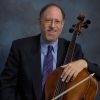
The Joy of Feuillard – A Sequential Approach to Teaching Bow Technique (Part 25 – Feuillard No. 35 – Variations #3-9)
Robert Jesselson
The next seven variations of Feuillard No. 35 all combine legato and staccato playing in various configurations over three strings. The issues involve coordination, and figuring out how to play smooth string crossings alternating with “catch and float” staccato strokes.
Variations #3 and #4:


At this point, most students are still working with the underlying concepts that we discussed in the last Blog: the twist motion and the release of the fingers while doing these variations. Zach made a lot of progress while practicing these things during the week. Today’s videos demonstrate that he is absorbing the new concepts, compared to the videos in last week’s Blog. At the end of the next video, Zach had a “revelation” about the relationship between the twist motion and the release of the fingers.
It is an important “lightbulb” moment when students put the new concepts into their own words and can verbalize things their own way.
Variations #5, #6 and #7:



These next variations are all continuing to work with the alternating staccato and legato strokes. Besides the bow technique that they are learning, one of the main issues for most students involves their ability to concentrate. Having taught these same Feuillard variations for more than forty years I am finding that nowadays it is more difficult for students to concentrate for a long time on one task than in the past. However I feel it is especially important for us to help this generation of young people improve their ability to focus and concentrate. These variations can help people figure out how to do that. They are like Zen exercises which train us to “be in the moment”. Even though each variation only takes a minute or so to play, it is vital to build up a reservoir of these concentration experiences. When they play four or five of these variations in a lesson, and are able to focus throughout, the students are gaining valuable training towards the concentration that is required for playing an entire Bach suite or a major concerto. There are no short-cuts in this training. So while it might seem “boring” or “torture” to put students through this regime, it is a necessary part of the process for training the brain. That, and their weekly scales and arpeggios, and their etudes. And while some teachers may find it “boring” or “torture” to listen to these – especially one student after another – I think it is important for me to just sit there and listen…
In this next video I am keeping Zach’s full “performances” of these three variations, to show how well he was doing with his concentration. This represents a big step forward for him; it wasn’t long ago – working through the previous Feuillard pages – that he was still having problems with concentrating for this length of time. And the improvement in his concentration is reflected in his ability to learn his etudes faster, and his ability to memorize his Bach suite easier and more securely.
In Variation #7 I needed to work with Zach on the issue of the part of the bow to use (the middle) and the lift that is required.
Variation #8:

Variation #8 should be played two different ways: staccato and spiccato (much like Feuillard No. 33 #12 and No. 34 #37). As I mentioned in an earlier blog, the staccato stroke is called either “up-bow staccato”, “slurred staccato” or “hooked staccato”. The spiccato stroke is called “flying spiccato”. I was pleased that Zach remembered the different techniques for producing these two different strokes from when he did it a few months before in Feuillard No. 33.
So, Up-bow Staccato requires the following:
- low contact point
- first finger involvement
- closer to the middle of the bow
- lower arm movement
- heavier sound
And the Flying Spiccato requires:
- higher contact point
- little finger (on top of the stick!)
- closer to the frog, depending on the speed
- lighter sound
- faster tempo
Variation #9:

This variation involves Down-bow Staccato (it would probably have to be very fast to do an effective Flying Spiccato stroke here – so we won’t do that now). Zach remembered the various requirements for this stroke from earlier discussions, on prompting. I usually repeat these questions several times in different variations until it is internalized and “obvious”. From experience I find that it takes a while for that to happen – so in the meantime I keep asking the same questions…
Next week’s blog will continue the staccato and legato strokes over three strings with 16 variations that coordinate these horizontal and vertical motions.
*If you have questions or comments about The Joy of Feuillard, Dr. Robert Jesselson can be reached directly at rjesselson@mozart.sc.edu.
Subjects: Repertoire, Technique
